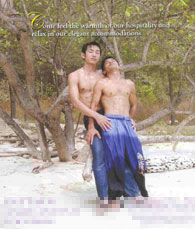Fridae is a proud sponsor of the Sexualities, Genders, and Rights in Asia: 1st International Conference of Asian Queer Studies to be held in Bangkok from 7-9 July 2005. Brian Curtin will present his paper "Thailand's Gay Male Sexual Cultures and the Problem of Visual Representation" at the conference.
"� pornography is not just a collection of images; it is a relationship between people that is mediated by images."
- Lawrence Chua in 'Looking for Ali: Notes from "How I learned to stop worrying and love the spectacle,"' Bidoun Magazine

By now the details of an incident during March 2004 when the Thai police raided a Bangkok tour company, which specialises in gay and lesbian markets, have been burned, blurred and broadcast into the uncollective consciousness of the gay community here. The police were acting in cooperation with the Australian Embassy in investigating one of the company's Australian directors for possible pedophilia charges and, further, a member of TAT (Tourism Authority Thailand) had contacted the police with the claim that the tour company organised sex tours. The director in question and another were arrested and brought to trial. As a result of the police confiscating copies of a magazine titled Thai Guys, copies that were given to customers for free, charges of distributing pornography (illegal in Thailand) were brought, and the two men were given fines and suspended sentences. TAT also suspended the company's business license for six months. No other charges were brought against the director who was a concern to the Australian Embassy and the sex tour claim proved unfounded.
Thai Guys was a listings magazine with pin-up imagery of Asian men, was distributed free in Thailand and unconnected to the tour company. The charge of commercially distributing pornography was based on the claim that the eroticised imagery in the magazine could be linked to the company's targeting of gay men as a tourist market for Thailand. That is, the company was perceived as profiting from a 'pornographic' image of Thailand. The actual producers of Thai Guys were not contacted throughout.
I am less interested in the convoluted, if not bizarre, means by which legal charges were brought, or the credibility of any understanding of pornography suggested, than the question of what Judge Suttikorn thought he was looking at on the pages of Thai Guys. The Judge was reported as saying of one image of a shirtless man that the line of hair which ran down from his navel would certainly arouse gay men, therefore the image was pornographic. Silly generalisations and homophobia withstanding, Judge Suttikorn did recognise the attempt of the photograph to register a trace of the real. That is, the model was shown as embodied, as possessing a sense of touch which is a well-worn convention of fetishism and sits against those glossy pin-ups where the model is airbrushed, idealised and physically abstracted. To understand this as a trope of 'gay' cultural expression is one thing but such visual conventions have been noted by photography historians such as Abigail Solomon-Godeau and Thomas Waugh in their studies of photography produced by gay men, and analysed outside essentialist views of gay male sexualities. Further, within Thailand and possibly elsewhere, one otherwise only finds such conventions (if at all) within magazines ostensibly aimed at women, such as Image, thereby rendering the fetishism in heterosexual terms and neutralising the supposed 'problem' of gay male spectatorship. I will return to the question of gay male spectatorship later but, for the moment, it is enough to acknowledge that Judge Suttikorn and the police registered this particular response.
Representation and 'Face'
As not part of any wider program to investigate how gay tour agencies operate on behalf of Thailand, the localised nature of this incident ensured the police's lack of concern with the bigger picture, so to speak. In fact, to look at a bigger picture is to see that the company directors and the police share a comparable point of view; the tour company was a founding member of the Thailand Alternative Travel Association (TATA) and TATA hold a remit to, I quote from their aims, put a more positive face on Thailand for gay visitors. TATA are a group of Thailand-based businesses that target gay markets and want to ensure this country can compete with, among other places, Palm Springs and Mykonos in attracting gay [male] tourists. The use of the term 'positive face' is concerned with addressing the reputation of Thailand's commercial sex industries for its existing international image, or face. Businesses involved in prostitution or the promotion of sex work cannot join TATA, though they acknowledge, uncritically, that these industries encourage, as well as discourage, gay visitors.
The difference between TATA and the police, of course, is that the former presumably do not seek to regulate or censor the type of imagery that concerned Judge Suttikorn. But in linking ideas of positive face to the disassociation of commercial sex TATA raise the question - and I will show that this is a question - of how commercial sex already effects Thailand's existing 'face'. Images of commercial sex are purported to be dominant otherwise TATA would have no reason to aim to disassociate them from Thailand's 'face'. But in a context which the Thai police brought attention to, the circulation of eroticised imagery aimed at gay male tourists, it is an open question how precisely images of commercial sex and a more generally sexualised image may be unproblematically distinguished.
The opposition by TATA, therefore, to the promotion of sex work as a negative image needs to reckon with a broader picture of how Thailand's gay scenes represent and are represented. This necessarily includes the fact that the promotional machinery for 'gay Thailand' typically lists ago-go bars, massage venues, and escort agencies alongside nightclubs, bars and restaurants and more, and often with a shared visual rhetoric. See, for example, comparisons in the use of imagery for advertisements for a gay-run hotel, resort and spa and a ago-go bar. Differences between the images are important and can be explored in detail elsewhere; for the moment, it is notable that each present a fantasy of male sexual availability through, amidst other devices, the presupposition of the gaze of a viewer.
Paradise Found

Gibberish of this kind undoubtedly inspired Peter A. Jackson's essay 'Tolerant but Unaccepting: The Myth of a Thai Gay Paradise'. Douglas Saunders more recently penned 'Thailand: How Gay is the Land of Smiles?' for fridae.com. Jackson is concerned to debunk misconceptions of a 'gay paradise' with examples of institutionalised homophobia in Thailand, such as Thai academic writing which claimed male homosexuality as a perversion in need of a cure. Elsewhere, however, he recognises that discourse and social practices in Thailand are not as closely entwined as Michel Foucault's writings on sexuality claimed they were in 'the West'. Saunders article balances apparent contradictions in Thailand between silence and openness and a commercial gay scene flourishing amidst social order clampdowns and calls for self-censorship. Further, he points out that five different gay guidebooks - a world record? - have been published on Thailand. Neither writers, however, trace how the notion of Thailand as 'gay paradise' has actually been constructed. While, as Jackson points out, one of the roots of the myth is in gay guidebooks such as Spartacus, the myth continues to be perpetuated, as I hope I have suggested, across a range of media and inside as well as outside of Thailand.
A critical question is not only how this myth is perpetuated and what forms it takes. The role of sex work is an issue, as TATA suggest, but, as the rhetoric of Alyson Tours points to, this issue may be dissipated within representations that deny Thai men any agency outside the stereotypical expression of 'traditional' Thai mores. In fact, the ultimate question may be what agency can be afforded to both acknowledge, with the aim of eventually resisting or upsetting, prevailing notions of Thailand as the land of sexual opportunity. If the images in question can be read one way, can they be read another?
Brian Curtin is an Irish-born artist based in Bangkok where he lectures in art and design related subjects. He was included in the recent Spirit of Art exhibition at HOF Gallery in Bangkok and his writing has previously appeared in Art Journal and Art 4D. Brian holds a PhD from the University of Bristol and researches generally on issues of cultural identity and visual representation. He will present his paper "Thailand's Gay Male Sexual Cultures and the Problem of Visual Representation" at the Sexualities, Genders, and Rights in Asia: 1st International Conference of Asian Queer Studies to be held in Bangkok from 7-9 July 2005.












 打印版本
打印版本










读者回应
抢先发表第一个回应吧!
请先登入再使用此功能。